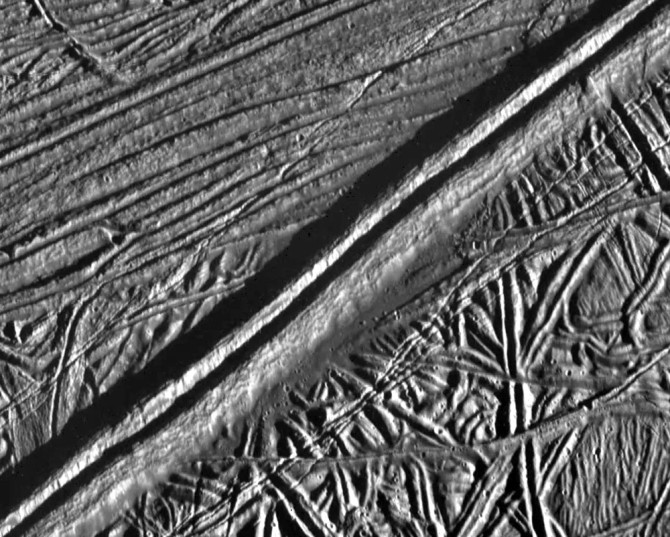An outer ice shell marked by "chaos terrain," a vast ocean, cryovolcanoes, misty plumes, gravitational tides and intense radiation.
Jupiter's moon Europa may have them all - and potentially conditions that could support life. To find out, NASA has launched its next flagship science mission, Europa Clipper - the space agency's first dedicated spacecraft mission to study an ocean world beyond Earth - and Cornell scientists will play a role in reporting discoveries about its habitability.
This view of the icy surface of Jupiter's moon, Europa, is a mosaic of two pictures taken by the Solid State Imaging system on board the Galileo spacecraft during a close flyby of Europa on Feb. 20, 1997. This double ridge is about 1.6 miles (2.6 kilometers) wide and stands some 330 yards (300 meters) high. The complexly ridged terrain seen here shows that parts of the icy crust of Europa have been modified by intense faulting and disruption, driven by energy from the planet's interior.
The mission is managed by NASA's Jet Propulsion Laboratory - where Jonathan Lunine, the David C. Duncan Professor in the Physical Sciences Emeritus in the College of Arts and Sciences (A&S) and a member of Europa Clipper's gravity science team, was recently named chief scientist - in partnership with the Johns Hopkins University Applied Physics Laboratory.
Four more faculty members are part of the official teams that will analyze data from the spacecraft's nine instruments and a gravity science experiment - investigating the moon's interior, composition and geology - when it begins 49 planned flybys of Europa starting in 2030, research that graduate students are helping to advance.
"One of the most fundamental discoveries made in the past two decades is that the ocean worlds of the outer solar system, including Europa, are likely to contain habitable environments that can support life as we know it," said Alex Hayes '03, M.Eng. '04, the Jennifer and Albert Sohn Professor of Astronomy (A&S), part of the team responsible for the mission's high-resolution imagery. "Europa Clipper represents the first step in the path toward a direct search for life outside of Earth."
Britney Schmidt, associate professor of astronomy and of earth and atmospheric sciences in A&S and Cornell Engineering, was involved in the mission's early design and works with the spacecraft's ice-penetrating radar instrument. Her Planetary Habitability and Technology Lab's research with an underwater robot may inform eventual exploration beneath the surfaces of ocean worlds like Europa.
"This has been the top priority mission for planetary science since the early 2000s," Schmidt said. "The science is going to be incredible."







